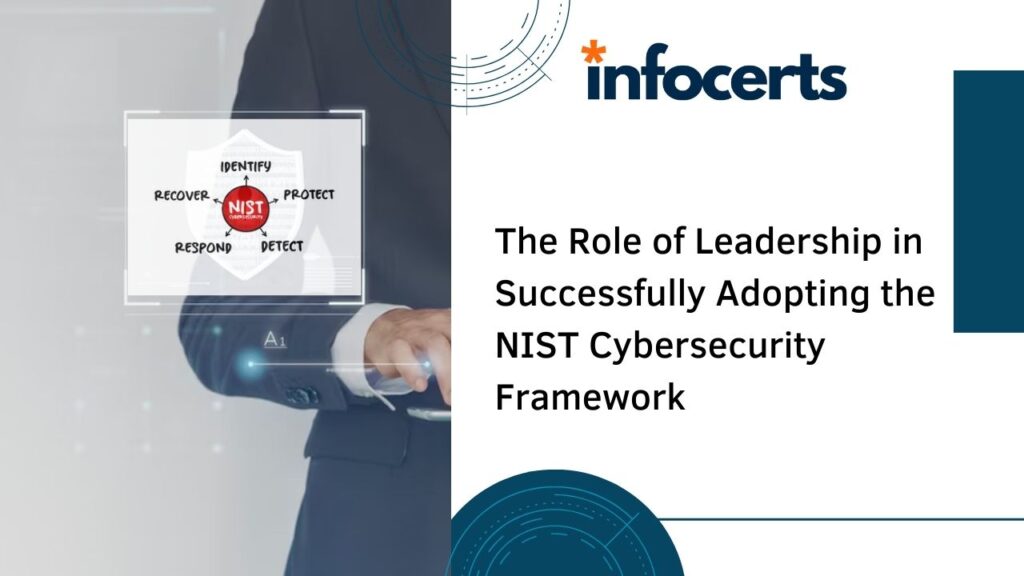Introduction: In today’s interconnected digital landscape, cybersecurity has become a critical concern for organizations of all sizes. To effectively manage the evolving threat landscape, the National Institute of Standards and Technology (NIST) developed the NIST Cybersecurity Framework (CSF). While implementing this framework is crucial, it requires strong Leadership in Cybersecurity Adoption and integration within an organization. In this blog post, we will explore the essential role of leadership in effectively adopting the NIST Cybersecurity Framework.
- Setting the Vision and Culture: Leadership plays a pivotal role in setting the vision and culture around cybersecurity within an organization. By championing a Culture of Security, leaders establish a mindset that prioritizes cybersecurity as a strategic business objective. They communicate the importance of the NIST CSF to all levels of the organization, emphasizing the collective responsibility to safeguard sensitive information and assets.
- Allocating Resources: Adopting the NIST CSF involves investing in appropriate resources, such as technology, training, and personnel. Leaders must allocate the necessary resources to implement the framework effectively. This includes budgeting for cybersecurity tools, ensuring the availability of skilled cybersecurity professionals, and providing ongoing training and awareness programs. By making these resources available, leaders demonstrate their commitment to cybersecurity and enable the successful Adoption of the NIST CSF.
- Driving Accountability: Leadership drives accountability by defining roles, responsibilities, and clear lines of authority within the Organization. They establish policies and procedures aligned with the NIST CSF, ensuring that everyone understands their obligations regarding cybersecurity. By holding individuals accountable for their actions and promoting a culture of compliance, leaders foster a proactive approach to cybersecurity, minimizing risks and vulnerabilities.
- Promoting Continuous Improvement: Leadership plays a critical role in promoting a cycle of continuous improvement in cybersecurity practices. They encourage regular assessments and audits to identify gaps, weaknesses, and areas for improvement. By embracing a culture of learning, leaders foster innovation and adaptability, allowing organizations to respond effectively to Emerging Threats and evolving best practices.
| Leadership Role | Description | Example |
| Setting the Vision and Culture | Establishing a cybersecurity mindset and strategic objectives within the organization. | CEO delivers a company-wide message on the importance of cybersecurity and integrates it into the company’s mission statement. |
| Allocating Resources | Providing the necessary resources to effectively implement the NIST CSF. | CIO allocates budget for cybersecurity tools, hires skilled cybersecurity professionals, and invests in employee training programs. |
| Driving Accountability | Defining roles, responsibilities, and policies related to cybersecurity and ensuring compliance. | CISO establishes clear guidelines for incident reporting and conducts regular security awareness training sessions for all employees. |
| Promoting Continuous Improvement | Encouraging ongoing assessments, audits, and adaptability to evolving threats and best practices. | IT Director initiates regular vulnerability assessments and encourages employees to share innovative ideas for strengthening cybersecurity measures. |
Conclusion: Successfully adopting the NIST Cybersecurity Framework requires strong leadership that sets the tone, allocates resources, drives accountability, and promotes continuous improvement. By embracing the NIST CSF, organizations can establish a robust cybersecurity posture that protects sensitive information, mitigates risks, and safeguards their reputation. Leadership’s active involvement and commitment to cybersecurity are essential to ensuring the framework’s effective implementation and long-term success. With leadership at the helm, organizations can navigate the ever-changing cybersecurity landscape with confidence and resilience.
FAQs
- What is the NIST Cybersecurity Framework?
- How does leadership play a role in adopting the NIST Cybersecurity Framework?
- Why is leadership important in cybersecurity adoption?
- What are the benefits of adopting the NIST Cybersecurity Framework?
- How can organizations ensure ongoing compliance with the NIST Cybersecurity Framework?
——————————————————————————————————————–
Infocerts, 5B 306 Riverside Greens, Panvel, Raigad 410206 Maharashtra, India
Contact us – https://www.infocerts.com

